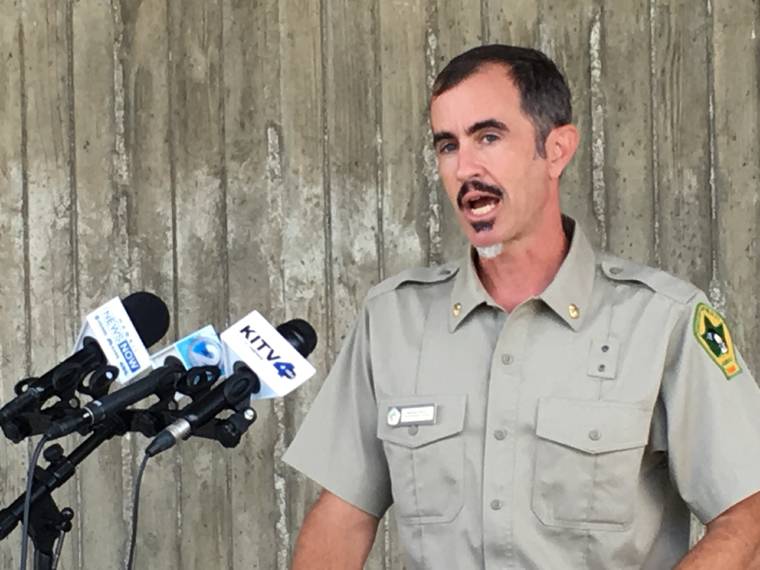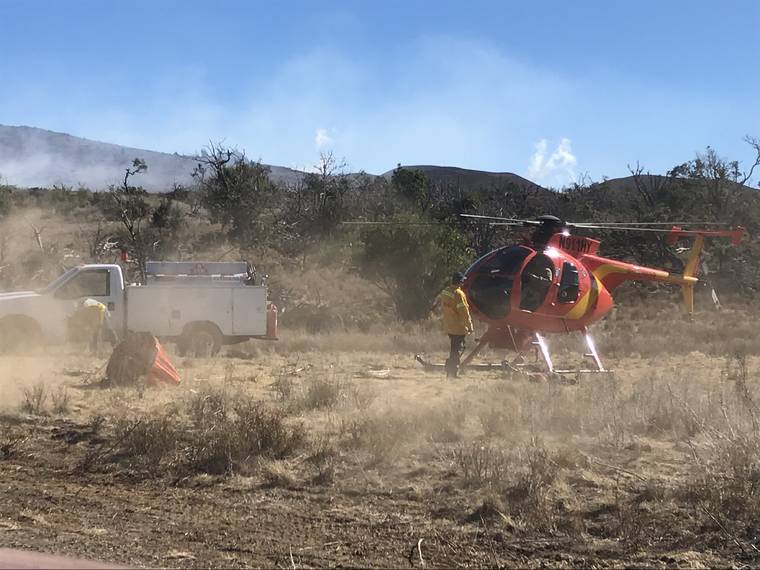HILO — Because of climate change, Hawaii’s wildfire season, previously confined to the summer months, is now year-round — which means the islands likely will see more wildfires.
Michael Walker, state Department of Land and Natural Resources fire prevention forester, made that startling pronouncement Monday during a news conference in Honolulu.
“Driven by our changing, warming climate, our fire season now starts in January and ends in December,” Walker told reporters. “Evidence of our year-round fire season has already been demonstrated this year. Our county fire department partners have responded to dozens of roadside brush fires statewide.
“Our Division of Forestry and Wildlife crews helped to extinguish a 200-acre fire in January on Maui and a 200-acre fire on Hawaii Island in February. A fire on Kauai last month on fallow agricultural lands above Waimea and Kekaha burned 2,100 acres. This fire burned in the exact same area in May of this year, in May 2017 and in the summer of 2012.”
Derek Wroe, a National Weather Service meteorologist, said that despite record rainfall last week across the western portion of the state, “large portions of Maui and the Big Island remain under extreme or severe drought.”
“It’s important to note that right now … we’re heading into the hottest and the driest portion of the year that we typically see,” Wroe said. “And because of that, we could see some worsening of drought conditions in some areas, and there will be impacts on fire starts and the way fire spreads due to those conditions.
“… As we head into this dry time of the year, usually it’s the leeward portions of the islands that see the hottest and driest conditions, even if the windward areas pick up a little bit more rainfall. So the fire risk over those leeward areas would still be quite high.”
Clay Trauernicht, a wildland fire specialist for the University of Hawaii Cooperative Extension Service, said increased rainfall and hurricane season can actually increase the risk of wildfires.
“Statewide, we’re dealing with about a million acres of grasslands, which are creating basically an ocean of high-fire risk around our communities and forests — and they’re very sensitive to these fluctuations in rainfall and drought,” Trauernicht said. “The greening up in the western part of the state … that means higher fire risks later, because we’re seeing accumulation of these fuels.”
Trauernicht said the fire risk remains high for the Big Island and Maui, hurricane season notwithstanding.
“In 2018, before Hurricane Lane and during the lead up to other storms, we actually saw big increases in fire risks — dry conditions, a lot of unmanaged grasslands created vulnerability to our communities and led to some fires with some of the biggest impacts that we saw during those storms. … As you’re prepping for hurricane season, remember to keep in mind that fire risk is something that we need to deal with.”
Walker said Hawaii “not only has a fire problem, we have a fuel problem.”
“As Hawaii’s industrial agriculture decreased from the ’60s through the ’90s, a lot of the lands that used to be in industrial ag production went fallow, and they got covered by these nonnative African grasses that are fire adaptive,” he said. “And one species in particular, Guinea grass, can grow 6 inches a day in optimal conditions. So immediately after the fire burns, in particular if there’s a forested area that burns as well, the grass then moves higher up in elevation … converting our native forests sometimes into these exotic grasslands.”
Walker said the Division of Forestry and Wildlife is taking applications for the U.S. Forest Service’s Wildland Urban Interface grant program. He said the program will provide up to $300,000 in matching funds to assist landowners with reducing the risk for wildfire on their properties.
“State lands are applicable, community associations, nonprofits, anybody that has a project that works within the state’s forest action plan is applicable. Also, the area has to be covered by a community wildfire protection plan, which most of the state is … ,” he said. “They have funds available for fire prevention, education, as well as hazardous fuel reductions. So that can be anything from creating a fuel break or a fire break, or … reducing hazardous fuels like a grassland with a controlled grazing program. The applicants’ funds can come from equipment time or labor or a variety of ways the applicant can come up with those matching funds.”
Applications must be turned in by Aug. 16. They’re available online at https://dlnr.hawaii.gov/forestry/fire/wildland-urban-interface-grants/.
Email John Burnett at jburnett@hawaiitribune-herald.com.











